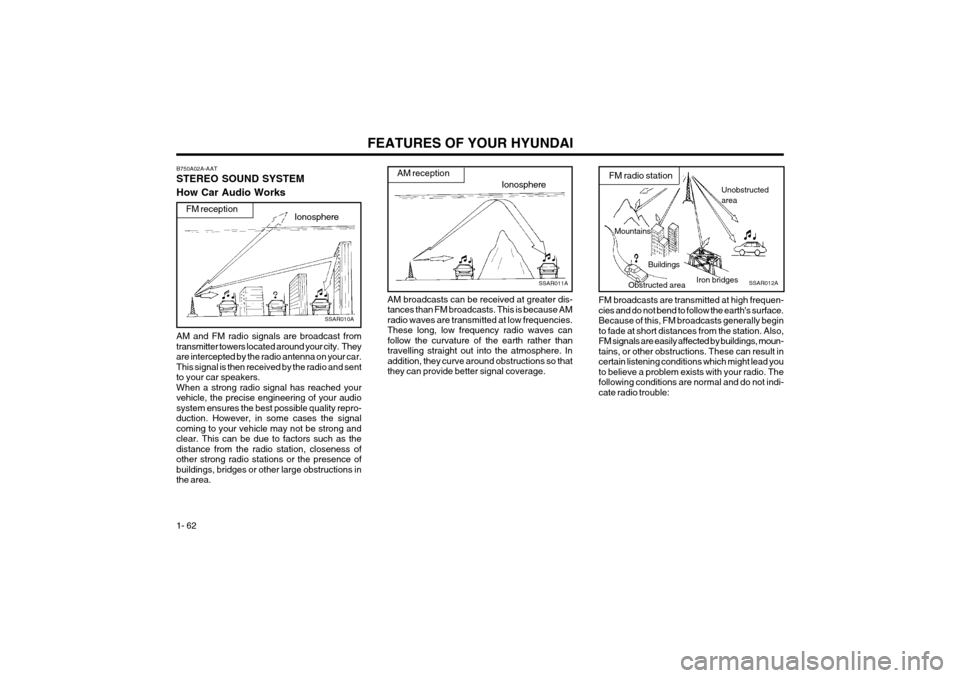2004 Hyundai Coupe engine cover
[x] Cancel search: engine coverPage 8 of 389

A100A01LA100A02LA100A04L
A100A03L
A100A01L-GAT GUIDE TO HYUNDAI GENUINE PARTS
1. What are Hyundai Genuine Parts?
Hyundai Genuine Parts are the same parts used by Hyundai Motor Companyto manufacture vehicles. They are de-signed and tested for the optimum safe-ty, performance, and reliability to ourcustomers.
2. Why should you use genuine parts? Hyundai Genuine Parts are engineeredand built to meet rigid manufacturingrequirements. Using imitation, counter-feit or used salvage parts are not cov-ered under the Hyundai New Vehicle Limited Warranty or any other Hyundaiwarranty. In addition, any damage to orfailure of Genuine Hyundai Partscaused by the installation or failure ofan imitation, counterfeit or used sal-vage part is not covered by Hyundai
Motor Company.
3. How can you tell if you are purchas- ing Hyundai Genuine Parts?Look for the Hyundai Genuine PartsLogo on the package (see below). The export specifications are written in English only. Hyundai Genuine Parts are only soldthrough authorized Hyundai Dealer-ship and Service Center.
Page 9 of 389

FEATURES OF YOUR HYUNDAI 1- 1
1. FEATURES OF
YOUR HYUNDAI
B010A01GK
B010A02A-GAT FUEL RECOMMENDATIONS Use Unleaded Gasoline Unleaded gasoline with a Pump Octane Rating of 87 (Research Octane Number 91) or highermust be used in Hyundai vehicle. If leaded gaso-line is used, it will cause the catalytic converter tobecome ineffective and the emission controlsystem to malfunction.This can also result in increased maintenanceexpense. To avoid accidental use of leaded fuel,the large nozzle used with leaded gasoline atservice stations can not be inserted into fuel tankopening of Hyundai vehicle. NOTE:
o For some countries, Hyundai vehicles are
designed to use leaded gasoline. Whenyou are going to use leaded gasoline, askto Hyundai dealer whether leaded gaso-line in your vehicle is available or not.
o Octane Rating of leaded gasoline is same with unleaded one.
B010B01A-AAT What About Gasohol? Gasohol (a mixture of 90% unleaded gasoline and 10% ethanol or grain alcohol) may be usedin your Hyundai. However, if your engine devel-ops driveability problems, the use of 100% un-leaded gasoline is recommended. Fuels withunspecified quantities of alcohol, or alcoholsother than ethanol, should not be used. B010D01S-AAT Do not Use Methanol Fuels containing methanol (wood alcohol) should
not be used in your Hyundai. This type of fuel canreduce vehicle performance and damage com-ponents of the fuel system. CAUTION: Your Hyundai's New Vehicle Limited War-ranty may not cover damage to the fuel sys-tem and performance problems that arecaused by the use of methanol or fuels con-taining methanol. B010E01A-AAT Gasolines for Cleaner AirTo help contribute to cleaner air, Hyundai recom- mends that you use gasolines treated with deter-gent additives, which help prevent deposit for-mation in the engine. These gasolines will helpthe engine run cleaner and enhance performanceof the Emission Control System. B010F01A-AAT Operation in Foreign Countries If you are going to drive your Hyundai in another country, be sure to:
o Observe all regulations regarding registra-
tion and insurance.
o Determine that acceptable fuel is available. B020A01S-GAT BREAKING IN YOUR NEW HYUNDAI During the First 2,000 Km (1,200 Miles) No formal "break-in" procedure is required with your new Hyundai. However, you can contributeto the economical operation and durability of yourHyundai by observing the following recommen-dations during the first 2,000 km (1,200 miles).
o Don't drive faster than 88 km/h (55 mph).
o While driving, keep your engine speed (rpm, or revolutions per minute) between 2,000 rpmand 4,000 rpm.
o Use moderate acceleration. Don't start, de- press the accelerator pedal fully.
1
Page 29 of 389

FEATURES OF YOUR HYUNDAI 1- 21
B240B01GK-GAT SRS Components and Functions The SRS consists of the following components: - Driver's Airbag Module - Passenger's Airbag Module- SRS Service Reminder Indicator (SRI)- SRS Control Module (SRSCM) The SRSCM continually monitors all elements while the ignition is "ON" to determine if a frontalor near-frontal impact is severe enough to re-quire airbag deployment. The SRS service reminder indicator (SRI) on the instrument panel will blink for about 6 secondsafter the ignition key is turned to the "ON" positionor after the engine is started, after which the SRIshould go out.
o Do not tamper with or disconnect SRS
wiring, or other components of the SRSsystem. Doing so could result in injury,due to accidental firing of the airbags orby rendering the SRS inoperative.
o Do not install a child restraint system in the front passenger seat position. A childrestraint system must never be placed inthe front seat. The infant or child could beseverely injured or killed by an airbagdeployment in case of an accident.
o Do not allow children to ride in the front passenger seat. If older children (teenag-ers and older) must ride in the front seat,make sure they are always properly beltedand that the seat is moved back as far aspossible.
o For maximum safety protection in all types of crashes, all occupants including thedriver should always wear their seat beltswhether or not an airbag is also providedat their seating position to minimize therisk of severe injury or death in the eventof a crash. Do not sit or lean unnecessarilyclose to the airbag while the vehicle is inmotion.
o The SRS airbag system must deploy very rapidly to provide protection in a crash. Ifan occupant is out of position because ofnot wearing a seat belt, the airbag mayforcefully contact the occupant causingserious or fatal injuries.
B240B01L
The airbag modules are located both in the center of the steering wheel and in the frontpassenger's panel above the glove box. Whenthe SRSCM detects a considerable impact to thefront of the vehicle, it will automatically deploy theairbags. CAUTION: Do not install or place any accessories (drinkholder, cassette holder, sticker, etc) on thefront passenger's panel above the glove boxin a vehicle with a passenger's air bag. Suchobjects may become dangerous projectilesand cause injury if the passenger's air baginflates.
B240B02L
Upon deployment, tear seams molded directly into the pad covers will separate under pressurefrom the expansion of the airbags. Further open-ing of the covers then allows full inflation of theairbags.
Page 32 of 389

FEATURES OF YOUR HYUNDAI
1- 24 o Do not tamper with or disconnect SRS
wiring, or other components of the SRS system. Doing so could result in injury,due to accidental firing of the airbags orby rendering the SRS inoperative.
o If components of the airbag system must be discarded, or if the vehicle must be
scrapped, certain safety preca utions must
be observed. Your Hyundai dealer knowsthese precautions and can give you the
necessary information. Failure to followthese precautions and procedures could
increase the risk of personal injury.
o If you sell your vehicle, be sure to inform the new owner of these important pointsand make certain that this manual is trans-ferred to the new owner.
o If your car was flooded and has soaked carpeting or water on flooring, youshouldn't try to start engine; have the car
towed to authorized Hyundai dealer.
WARNING:
o Do not install a child restraint system in
the front passenger seat position.
A child restraint system must never be placed in the front seat. The infant or childcould be severely injured by an airbagdeployment in case of an accident.
o Extreme Hazard! Do not use a reward facing restraint on a seat protected by anairbag in front of it!
o Modification to SRS components or wir- ing, including the addition of any kind ofbadges to the pad covers or modifications
to the body structure, can adversely affectSRS performance and lead to possibleinjury.
o For cleaning the airbag pad covers, use only a soft, dry cloth or one which hasbeen moistened with plain water. Solventsor cleaners could adversely affect theairbag covers and proper deployment ofthe system.
o No objects should be placed over or near the airbag modules on the steering wheel,instrument panel, and the frontpassenger's panel above the glove box,because any such object could cause harmif the vehicle is in a crash severe enoughto cause the airbags to inflate.
o If the airbags inflate, they must be re- placed by an authorized Hyundai dealer.
Page 57 of 389

FEATURES OF YOUR HYUNDAI 1- 49
o Pay particular attention to the driving con-
ditions whenever using the cruise control system.
o During cruise-control driving with a manual transaxle vehicle, do not shift into neutralwithout depressing the clutch pedal, or theengine will be overrevved. If this happens,depress the clutch pedal or release themain switch.
o With the cruise control engaged, when the brake pedal is applied, it is normal to hearthe cruise control system deactivate. Thisis an indication of normal system opera-tion.
o During normal cruise control operation, when the "SET(COAST)" is activated orreactivated after applying the brakes, thecruise control will energize after approxi-mately 3 seconds. This delay is normal.
B660F02E-AAT To Reset at a Slower Speed
B660B01GK
1. Push the control switch downward to "SET (COAST)" and hold it. The vehicle will decel- erate.
2. When the desired speed is obtained, release the control switch. While the control switch ispushed, the vehicle speed will gradually de-crease.
WARNING:
o Keep the main switch off when not using the cruise control.
o Use the cruise control system only when traveling on open highways in good weather.
o Do not use the cruise control when it may not be safe to keep the car at a constantspeed, for instance, driving in heavy orvarying traffic, or on slippery (rainy, icy orsnow-covered) or winding roads or over6% up-hill or down-hill roads.
B660D01E-GAT To Resume the Preset Speed
B660D01GK
The vehicle will automatically resume the speed set prior to cancellation when you push thecontrol switch upward to "RESUME (ACCEL)"position and release it, providing the vehiclespeed is above 40 km/h (25 mph). B660E01E-AAT To Reset at a Faster Speed
1. Push the control switch upward to "RESUME (ACCEL)" position and hold it.
2. Accelerate to desired speed and release the control switch. While the control switch is held, the vehicle will gradually gain speed.
Page 70 of 389

FEATURES OF YOUR HYUNDAI
1- 62
Mountains Buildings
Obstructed area Iron bridges
Unobstructed area
FM radio station
SSAR012A
Ionosphere
SSAR011A
AM receptionB750A02A-AAT STEREO SOUND SYSTEM How Car Audio Works
IonosphereFM reception
SSAR010A
AM and FM radio signals are broadcast from transmitter towers located around your city. Theyare intercepted by the radio antenna on your car.This signal is then received by the radio and sentto your car speakers.When a strong radio signal has reached yourvehicle, the precise engineering of your audiosystem ensures the best possible quality repro-duction. However, in some cases the signalcoming to your vehicle may not be strong andclear. This can be due to factors such as thedistance from the radio station, closeness ofother strong radio stations or the presence ofbuildings, bridges or other large obstructions inthe area. AM broadcasts can be received at greater dis-tances than FM broadcasts. This is because AMradio waves are transmitted at low frequencies.These long, low frequency radio waves canfollow the curvature of the earth rather thantravelling straight out into the atmosphere. Inaddition, they curve around obstructions so thatthey can provide better signal coverage.
FM broadcasts are transmitted at high frequen-cies and do not bend to follow the earth's surface.Because of this, FM broadcasts generally beginto fade at short distances from the station. Also,FM signals are easily affected by buildings, moun-tains, or other obstructions. These can result incertain listening conditions which might lead youto believe a problem exists with your radio. Thefollowing conditions are normal and do not indi-cate radio trouble:
Page 104 of 389

DRIVING YOUR HYUNDAI 2- 9
also increases the wear of the brake compo- nents.
o If a tire goes flat while you are driving, apply the brakes gently and keep the car pointedstraight ahead while you slow down. When
you are moving slowly enough for it to be safeto do so, pull off the road and stop in a safeplace.
o If your car is equipped with an automatic transaxle, don't let your car creep forward. Toavoid creeping forward, keep your foot on thebrake pedal when the car is stopped.
o Use caution when parking on a hill. Engage the parking brake and place the gear selectorlever in "P" (automatic transaxle) or in first or
reverse gear (manual transaxle). If your car isfacing downhill, turn the front wheels into thecurb to help keep the car from rolling. If yourcar is facing uphill, turn the front wheels awayfrom the curb to help keep the car from rolling.If there is no curb or if it is required by otherconditions to keep the car from rolling, blockthe wheels.
o Under some conditions your parking brake can freeze in the engaged position. This ismost likely to happen when there is an accu-mulation of snow or ice around or near therear brakes or if the brakes are wet. If there isa risk that the parking brake may freeze,apply it only temporarily while you put thegear selector lever in "P" (automatic) or in firstor reverse gear (manual transaxle) and blockthe rear wheels so the car cannot roll. Thenrelease the parking brake. o Do not hold the vehicle on the upgrade with
the accelerator pedal. This can cause thetransmission to overheat. Always use thebrake pedal or parking brake.
C120A02A-AAT ANTI-LOCK BRAKE SYSTEM (If Installed) The Anti-Lock Brake System (ABS) is designed to prevent wheel lock-up during sudden brakingor on hazardous road surfaces. The ABS controlmodule monitors the wheel speed and controlsthe pressure applied to each brake. Thus, inemergency situations or on slick roads, ABS willincrease vehicle control during braking. NOTE: During ABS operation, a slight pulsation maybe felt in the brake pedal when the brakes areapplied. Also, a noise may be heard in theengine compartment while braking. Theseconditions are normal and indicate that theanti-lock brake system is functioning proper-ly. WARNING:Your ABS will not prevent accidents due toimproper or dangerous driving maneuvers.Even though vehicle control is improved dur-ing emergency braking, always maintain asafe distance between you and objects ahead.Vehicle speeds should always be reducedduring extreme road conditions.The braking distance for cars equipped withan anti-lock braking system may be longerthan for those without it in the following roadconditions.During these conditions the vehicle shouldbe driven at reduced speeds.
o Driving on rough, gravel or snow-covered
roads.
o Driving on with tire chains installed.
o Driving on roads where the road surface is pitted or has different surface height.
The safety features of an ABS equipped ve-hicle should not be tested by high speeddriving or cornering. This could endanger thesafety of yourself or others.
Page 107 of 389

DRIVING YOUR HYUNDAI
2- 12 C160G01A-GAT To Keep Locks from FreezingTo keep the locks from freezing, squirt an ap- proved de-icer fluid or glycerine into the keyopening. If a lock is covered with ice, squirt it withan approved de-icing fluid to remove the ice. Ifthe lock is frozen internally, you may be able tothaw it out by using a heated key. Handle theheated key with care to avoid injury. NOTE: The proper temperature for using the immo-bilizer key is from -40°C to 80°C. If you heatthe immobilizer key over 80°C to open thefrozen lock, it may cause damage to thetransponder in its head. C160H01A-AAT Use Approved Anti-Freeze in Window Washer System To keep the water in the window washer system from freezing, add an approved anti-freeze solu-tion in accordance with instructions on the con-tainer. Window washer anti-freeze is availablefrom Hyundai dealers and most auto parts out-lets. Do not use engine coolant or other types ofanti-freeze as these may damage the finish.
C160B01A-GAT Snowy or Icy ConditionsTo drive your vehicle in deep snow, it may be necessary to use snow tires or to install tirechains on your tires. If snow tires are needed, itis necessary to select tires equivalent in size andtype to the original equipment tires. Failure to doso may adversely affect the safety and handlingof your car. Speeding, rapid acceleration, sud-den brake applications, and sharp turns arepotentially very hazardous practices. Duringdeceleration, use engine braking to the fullestextent. Sudden brake applications on snowy oricy roads may cause skids to occur. You need tokeep sufficient distance between the vehicle infront and your vehicle. Also, apply the brakegently. It should be noted that installing tire chainson the tire will provide a greater driving force, butwill not prevent side skids. NOTE: Tire chains are not legal in all provinces.Check province laws before fitting tire chains. C160C01A-AAT Use High Quality Ethylene Glycol Coolant Your Hyundai is delivered with high quality ethyl- ene glycol coolant in the cooling system. It is theonly type of coolant that should be used becauseit helps prevent corrosion in the cooling system,lubricates the water pump and prevents freezing.Be sure to replace or replenish your coolant in
C160D01F-AAT Check Battery and Cables Winter puts additional burdens on the battery system. Visually inspect the battery and cablesas described in Section 6 (See page 6-18). Thelevel of charge in your battery can be checkedby your Hyundai dealer or a service station. C160E01A-AAT Change to "Winter Weight" Oil if Necessary In some climates it is recommended that a lower viscosity "winter weight" oil be used during coldweather. See Section 9 for recommendations. Ifyou aren't sure what weight oil you should use,consult your Hyundai dealer. C160F01F-GAT Check Spark Plugs and Ignition Sys- tem Inspect your spark plugs as described in Section 6 (See page 6-8) and replace them if necessary.Also check all ignition wiring and components tobe sure they are not cracked, worn or damagedin any way.
accordance with the maintenance schedule inSection 5. Before winter, have your coolant test-ed to assure that its freezing point is sufficient forthe temperatures anticipated during the winter.